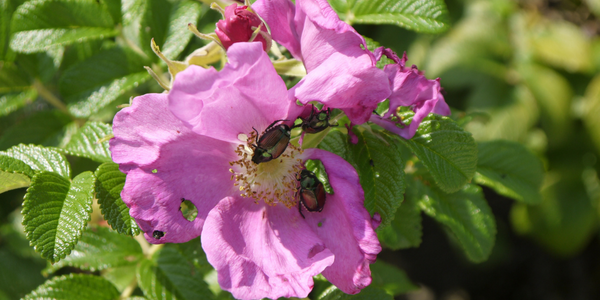
Do squished Japanese beetles attract more beetles?

I have read online that you should carry a pail of soapy water and pluck off the Japanese Beetles and drown them and to never squish them. What if I don’t have one handy? What can I do with these massively destructive creatures eating my beautiful blooms.
While always a hot topic this time of year, it seems like the bug population is having a really great year in most gardens. Let’s take a look at the questions above and see if the internet is right?
The following are responses from Dr. Whitney Cranshaw, Colorado State University Professor Specialist in Entomology and Dr. Dan Potter, University of Kentucky Professor of Entomology that can also be found on the internet. This specific conversation was on the Colorado State extension website.
I have copied the parts that should be of interest here:
“Should one squash Japanese beetles when dispatching them? The concern is that by squashing them it will result in release of chemicals that may attract other Japanese beetles.
I have been trying to check out whether there is any basis for this and the bottom line is that squashing them will not increase attraction. Females do produce a sex attractant that males respond to, but it is no longer produced after mating.
Aggregations of Japanese beetles are commonly observed. However, the attractants that produce these aggregations are chemicals that are released by the plants in response to Japanese beetle feeding - not attractants produced by the beetles. (Therefore, if you reduce the amount of feeding you reduce the recruitment of other beetles to the plants.)

Dan Potter of the University of Kentucky has long worked on this insect and what follows are some of his comments on this subject:
As far as is known, JB adults do not produce an aggregation pheromone. Their typical aggregation on host plants is mediated by feeding-induced plant volatiles, mostly floral or fruit-like compounds, which the beetles exploit as kairomones for locating suitable host plants.
With >300 host plants, JB is exposed to many different types of plant secondary chemicals. We found no consistent differences in constitutive volatile bouquets emitted by resistant or susceptible plants. Acceptance/rejection is based on the balance of positive (e.g., sugars) and negative (deterrent nasty stuff) stimuli encountered at the leaf surface, typically after a “test bite”. JB will land on and bite resistant plants (e.g., silver maple, redbud) but then fly off, as opposed to staying and feeding on a linden, purple leaf plum, or other palatable plant. Once the plant is “tasted” and found to be acceptable, progressively more feeding damage (probably interacting with enzymes in the beetles’ saliva) induces a rich blend of floral and fruity volatiles that draws in more JB “like sharks to a blood trail”. This phenomenon is also involved in the typical “top-down” feeding pattern within plant canopies.
Female JB cease production of the sex pheromone after the first mating which inevitably occurs when they first emerge from the ground as virgins. Later matings occur on plants in the aggregations mediated by plant volatiles....Baiting a trap with already-mated females will attract few or no male beetles, whereas baiting with a virgin female will attract hordes. “
The full document can be found here

So perhaps contrary to wisdom found on flower growing pages on the internet squashing female beetles will not attract more beetles.
Go ahead and squash them.



